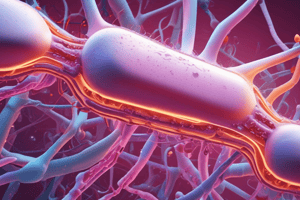Podcast
Questions and Answers
When a neuron becomes hyperpolarized, what is the effect on its membrane potential?
When a neuron becomes hyperpolarized, what is the effect on its membrane potential?
- The membrane potential becomes less negative than the resting potential
- The membrane potential becomes more negative than the resting potential (correct)
- The membrane potential remains unchanged
- The membrane potential returns to zero
What is the main function of sodium-potassium pumps in neurons?
What is the main function of sodium-potassium pumps in neurons?
- To maintain a uniform ion concentration outside the neuron
- To increase intracellular calcium levels
- To regulate the resting membrane potential (correct)
- To generate nerve impulses directly
Which ions are primarily responsible for the polarization of a nerve cell's membrane?
Which ions are primarily responsible for the polarization of a nerve cell's membrane?
- Potassium (K+) and Sodium (Na+) (correct)
- Chloride (Cl-) and Phosphate (PO4-2)
- Bicarbonate (HCO3-) and Sulfate (SO4-2)
- Calcium (Ca2+) and Magnesium (Mg2+)
What role do voltage-gated channels play in the transmission of a nerve impulse?
What role do voltage-gated channels play in the transmission of a nerve impulse?
What occurs when the membrane potential decreases from the resting state?
What occurs when the membrane potential decreases from the resting state?
What is the resting membrane potential value for a typical nerve cell?
What is the resting membrane potential value for a typical nerve cell?
Which of the following best describes the term 'membrane potential'?
Which of the following best describes the term 'membrane potential'?
What primarily contributes to the negative resting membrane potential in neurons?
What primarily contributes to the negative resting membrane potential in neurons?
What role does the sodium potassium pump play in maintaining resting membrane potential?
What role does the sodium potassium pump play in maintaining resting membrane potential?
What happens to the membrane potential when an action potential is triggered?
What happens to the membrane potential when an action potential is triggered?
What defines a threshold stimulus in neurons?
What defines a threshold stimulus in neurons?
How long does it typically take for a neuron to return to its resting state after an action potential?
How long does it typically take for a neuron to return to its resting state after an action potential?
What happens to chloride ions (Cl-) in relation to the interior of the cell?
What happens to chloride ions (Cl-) in relation to the interior of the cell?
During the depolarization phase of an action potential, what primarily occurs?
During the depolarization phase of an action potential, what primarily occurs?
Which statement about ion movement in neurons is true?
Which statement about ion movement in neurons is true?
Flashcards
Action Potential
Action Potential
A rapid change in membrane potential, triggered by a stimulus, crucial for neuronal communication.
Sodium-Potassium Pump
Sodium-Potassium Pump
A protein that maintains the concentration gradient of sodium (Na+) and potassium (K+) ions across the cell membrane.
Repolarization
Repolarization
The change in membrane potential from a positively charged interior back to a negatively charged interior.
Depolarization
Depolarization
Signup and view all the flashcards
Resting Membrane Potential
Resting Membrane Potential
Signup and view all the flashcards
Potassium Ions (K+)
Potassium Ions (K+)
Signup and view all the flashcards
Leakage Channels
Leakage Channels
Signup and view all the flashcards
Sodium Ions (Na+)
Sodium Ions (Na+)
Signup and view all the flashcards
Threshold Stimulus
Threshold Stimulus
Signup and view all the flashcards
Membrane Potential
Membrane Potential
Signup and view all the flashcards
Nerve Impulse
Nerve Impulse
Signup and view all the flashcards
Depolarization
Depolarization
Signup and view all the flashcards
Action Potential
Action Potential
Signup and view all the flashcards
Resting Membrane Potential (RMP)
Resting Membrane Potential (RMP)
Signup and view all the flashcards
Ion Distribution
Ion Distribution
Signup and view all the flashcards
Polarization (of nerve cell)
Polarization (of nerve cell)
Signup and view all the flashcards
Hyperpolarization
Hyperpolarization
Signup and view all the flashcards
Neurolemma
Neurolemma
Signup and view all the flashcards
Voltage-gated Channels
Voltage-gated Channels
Signup and view all the flashcards
Sodium-Potassium Pump
Sodium-Potassium Pump
Signup and view all the flashcards
Study Notes
Hyperpolarization
- Hyperpolarization refers to a change in the membrane potential of a neuron making it more negative.
- This makes the neuron less likely to fire an action potential.
Sodium-Potassium Pump
- The sodium-potassium pump actively transports sodium ions out of the neuron and potassium ions into the neuron.
- This maintains the concentration gradients of these ions, which are crucial for the generation of action potentials.
Polarization of a Nerve Cell
- The polarization of a nerve cell's membrane is primarily due to the unequal distribution of ions across the cell membrane.
- The interior of the cell is typically more negative compared to the exterior due to the presence of negatively charged proteins and a higher concentration of potassium ions inside the cell.
Voltage-Gated Channels
- Voltage-gated channels are specialized protein channels in the neuron's membrane that open or close in response to changes in the membrane potential.
- They play a crucial role in the transmission of nerve impulses by allowing the rapid inflow or outflow of specific ions, contributing to the depolarization and repolarization phases of an action potential.
Decreasing Membrane Potential
- When the membrane potential decreases from the resting state, the neuron becomes less polarized.
- This can be caused by an influx of positively charged ions, such as sodium.
Resting Membrane Potential
- The resting membrane potential of a typical nerve cell is around -70 millivolts (mV).
- This negative value is maintained by the sodium-potassium pump and the selective permeability of the cell membrane to different ions.
Membrane Potential
- Membrane potential refers to the electrical potential difference across the cell membrane of a neuron.
- It is a measure of the relative charge difference between the inside and outside of the cell.
Negative Resting Potential
- The negative resting membrane potential in neurons is primarily due to the presence of negatively charged proteins inside the cell and the selective permeability of the cell membrane, allowing potassium ions to leak out more easily than sodium ions.
Sodium-Potassium Pump and Resting Potential
- The sodium-potassium pump contributes to maintaining the resting membrane potential by actively pumping three sodium ions out of the cell for every two potassium ions pumped in.
- This process consumes energy and helps to establish and maintain the concentration gradients of these ions, contributing to the negative charge inside the cell at rest.
Membrane Potential During Action Potential
- When an action potential is triggered, the membrane potential rapidly rises to a positive value as sodium ions enter the cell, and then drops back down to a negative value as potassium ions leave the cell.
- This process is driven by the opening and closing of voltage-gated sodium and potassium channels.
Threshold Stimulus
- A threshold stimulus is the minimum level of stimulation required to trigger an action potential in a neuron.
- This threshold is typically around -55 mV, and it represents the point at which the depolarization is sufficient to open enough voltage-gated sodium channels to create a positive feedback loop.
Returning to Resting State
- It typically takes a few milliseconds for a neuron to return to its resting state after an action potential.
- This recovery is due to the inactivation of sodium channels, the opening of potassium channels, and the activity of the sodium-potassium pump.
Chloride Ions (Cl-)
- Chloride ions (Cl-) are generally more concentrated outside the cell compared to the interior during the resting state.
- They have a role in maintaining the electrical charge balance across the membrane, but their movement during action potentials is less significant compared to sodium and potassium ions.
Depolarization Phase
- The depolarization phase of an action potential is characterized by the influx of sodium ions into the neuron.
- This influx creates a rapid rise in the membrane potential, making the interior of the cell more positive.
Ion Movement in Neurons
- The movement of ions across the neuronal membrane is crucial for the generation and transmission of nerve impulses.
- The sodium-potassium pump maintains the concentration gradients of sodium and potassium ions, while voltage-gated channels allow for the rapid influx and efflux of these ions during action potentials.
Studying That Suits You
Use AI to generate personalized quizzes and flashcards to suit your learning preferences.




